
First Look: Rail-Related RAISE Grantees for FY23
Written by Marybeth Luczak, Executive Editor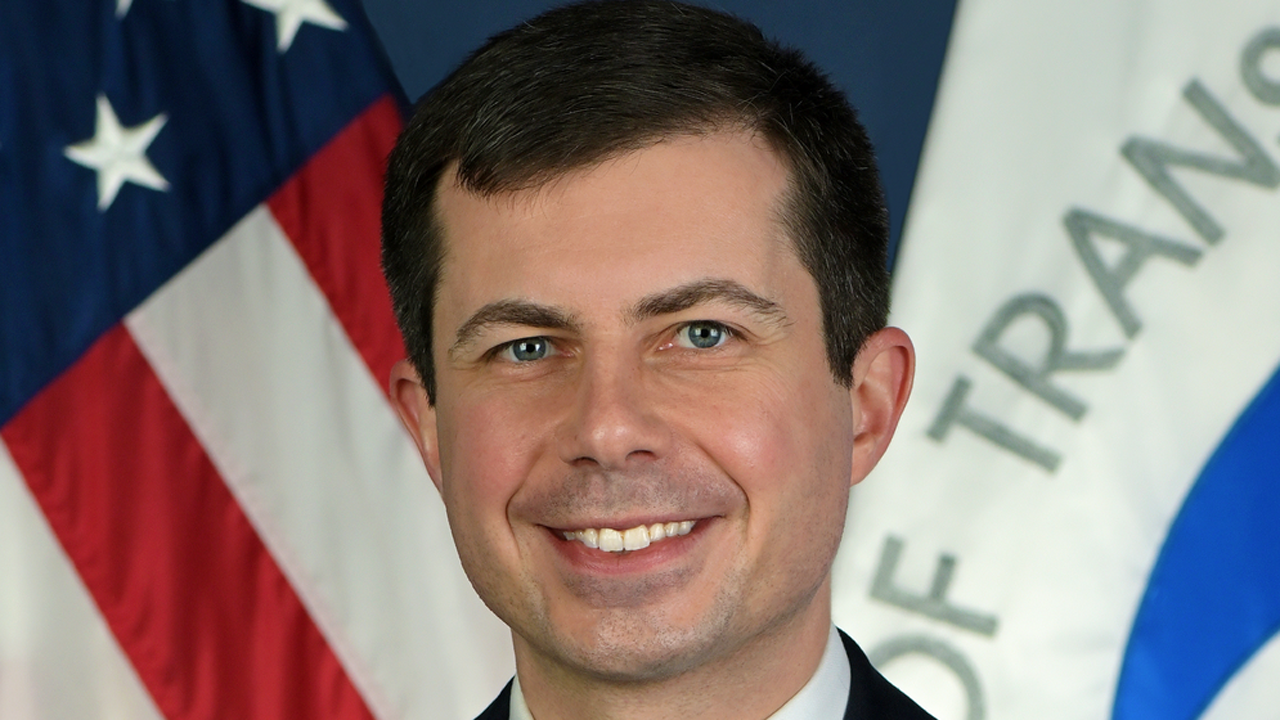
U.S. Transportation Secretary Pete Buttigieg
More than $244 million in FY 2023 RAISE (Rebuilding American Infrastructure with Sustainability and Equity) program grants will be distributed to 13 freight and passenger rail-related projects in 11 states, according to a U.S. Department of Transportation (USDOT) report released June 28. Funding will go toward Brightline West high-speed intercity passenger rail station construction, Southeastern Pennsylvania Transportation Authority (SEPTA) trolley modernization, Hoosier Southern Railroad track replacement, PortMiami expansion, and highway/rail grade crossing improvements, among other projects.
“RAISE discretionary grants help project sponsors at the state and local levels, including municipalities, Tribal governments, counties and others complete critical freight and passenger transportation infrastructure projects that they may not have had the funding to carry out prior to passage of President Biden’s infrastructure law,” USDOT said. “The eligibility requirements of RAISE allow project sponsors to obtain funding for projects that are harder to support through other USDOT grant programs.”
This year’s allocations include more than $2.2 billion for 162 nationwide projects. Half of the RAISE funding will be used in rural areas and the other half in urban areas, according to USDOT. Additionally, 70% of the grants will go toward projects in regions defined as an Area of Persistent Poverty or a Historically Disadvantaged Community. The Department said it received $15 billion in requests for the $2.26 billion in funding available.
“Using the funds in President Biden’s infrastructure law, we are helping communities in every state across the country realize their visions for new infrastructure projects,” U.S. Transportation Secretary Pete Buttigieg said. “This round of RAISE grants is helping create a new generation of good-paying jobs in rural and urban communities alike, with projects whose benefits will include improving safety, fighting climate change, advancing equity, strengthening our supply chain, and more.”
Rail-related RAISE projects (by state) include:
- California — BRIGHTLINE WEST HIGH-SPEED INTERCITY PASSENGER RAIL SYSTEM – HIGH DESERT STATIONS PROJECT: San Bernardino County Transportation Authority (SBCTA) will receive $25 million to fund the final design and construction of two intercity passenger rail stations and associated facilities in Hesperia and Victor Valley on the Brightline West high-speed rail corridor (see image below). USDOT said the project “is strong in mobility and community connectivity. It will improve system-wide connectivity with access to transit, micro-mobility and mobility on-demand.” Each of the stations will be designed and built as a multimodal hub allowing travelers to transfer to other non-rail modes of transportation easily, the Department noted. The stations will be fully accessible, ADA compliant, and include surface parking lots, bus pick-up/drop-off areas, and kiss and ride areas. “The High Desert stations are an integral component to our 218-mile [Las Vegas-to-Rancho Cucamonga, Calif.] system and will connect millions of residents with America’s first true high-speed rail system,” said Sarah Watterson, President of Brightline West. “We’re moving towards a groundbreaking later this year, kickstarting one of the largest job creators in the country and setting the stage for a new era in transportation. We are appreciative of our federal partners, the SBCTA and all those who support our system.” In April, the Nevada Department of Transportation in coordination with Brightline West applied for $3.75 billion from the Federal-State Partnership for Intercity Passenger Rail Grant Program, which authorized by the Infrastructure Investment and Jobs Act, makes funding available for projects that expand or establish new intercity passenger rail service.
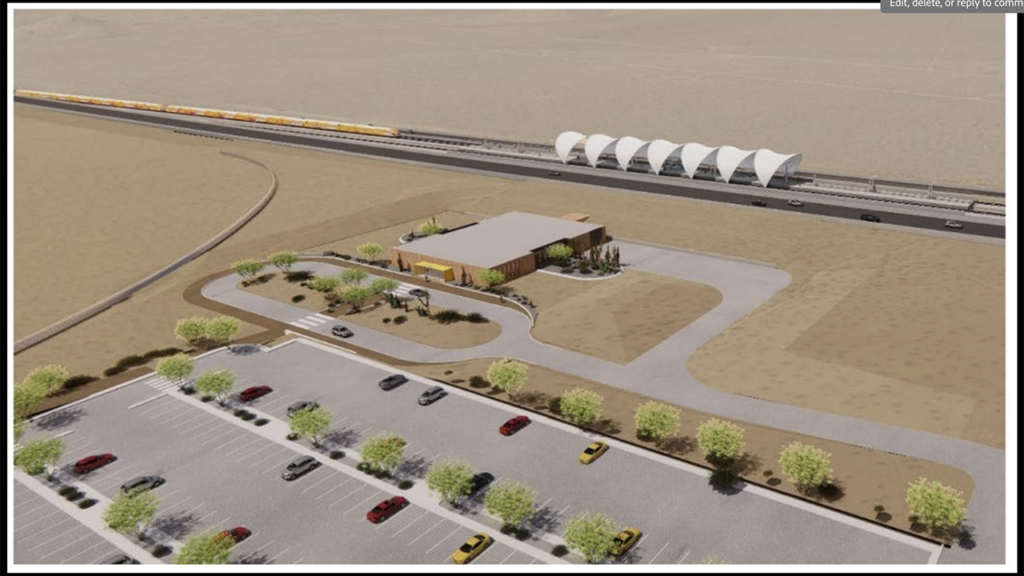
- California — FRESNO HIGH-SPEED RAIL STATION HISTORIC DEPOT RENOVATION AND PLAZA ACTIVATION: California High-Speed Rail Authority (CHSRA) will receive $20 million to renovate, modernize and preserve the Fresno rail station, a historic passenger depot building. The project will also provide electric vehicle charging infrastructure and space for future transit charging “in anticipation of the future California high-speed rail multimodal station,” according to USDOT. “The historic depot structures, which have seen a lack of investment for 50 years, will be returned to a state of good repair,” the Department said. Additionally, the project is slated to “improve and draw increased economic and social activity to an underutilized area next to Fresno’s city core by better connecting Chinatown and Downtown Fresno”; “provide environmental benefits by encouraging modal shift to transit and active transportation modes, as well as provide electric infrastructure for electric vehicles and battery-electric buses”; and “mitigate urban heat island intensities.” The total project cost is $33.2 million, and includes matching funds of $13.2 million from CHSRA. “This restoration project will allow us to prepare for future high-speed rail service, while at the same time, build public gathering areas in an underused and underinvested area of Fresno,” CHSRA Board Chair Tom Richards said. “When future riders come visit us, we want them to see a vibrant, family-friendly downtown area even before our first trains stop at the station.”
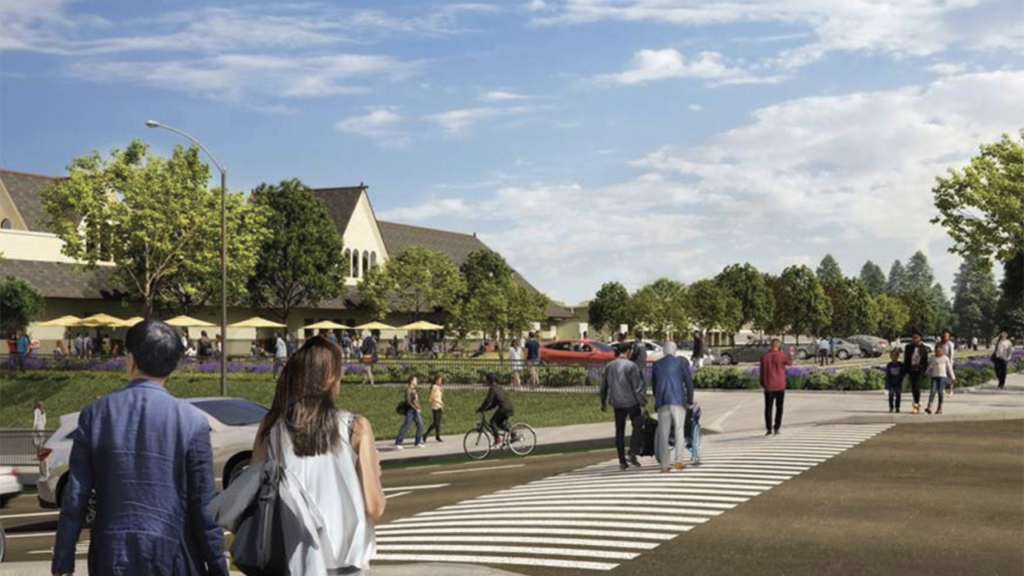
- California — PALOMAR STREET GRADE SEPARATION PROJECT: IMPROVING SAFETY, ACCESS, AND CIRCULATION: San Diego Association of Governments will receive $21.5 million to grade separate an existing street from a rail corridor that serves passenger and freight railroads; right-of-way acquisitions and utilities relocation will also be funded (see map below). The project will reduce emissions by reducing vehicle idling while rail vehicles pass, according to USDOT, and the improved pedestrian and bicycle features will also make the Palomar Transit Center more accessible.
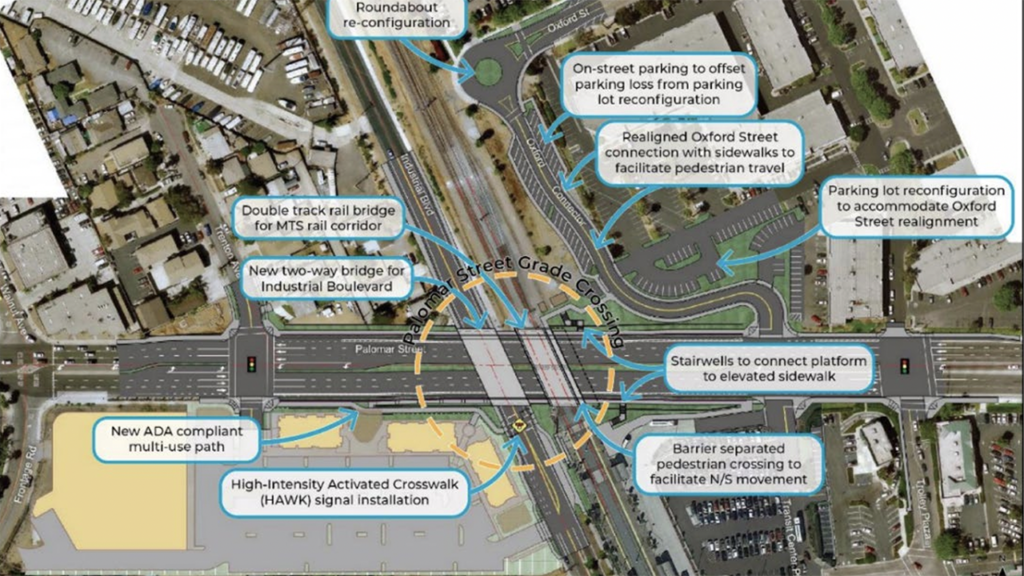
- Connecticut — DOWNTOWN NEW LONDON MULTIMODAL UTILIZATION IMPROVEMENTS PROJECT: The city of New London will receive $17 million to fund construction of five project components: expansion of the Water Street Public Parking Garage; transit hub; National Coast Guard Museum Association pedestrian bridge and public access; high-speed ferry terminal; and Union Train Station restoration and renovation. According to USDOT, the project will be delivered through a formal public-private partnership of the United States Coast Guard, state of Connecticut, city of New London, National Coast Guard Museum Association, and Cross Sound Ferry Services.
- Florida — PORTMIAMI NET ZERO PROGRAM: CARGO SUPPLY CHAIN MASTER PLAN: Miami-Dade County will receive $5 million to complete portions of a Master Plan. This “planning project will include both on-port and off-port planning and a design for an optimized sequence of services from the seaport to and from inland ports,” USDOT reported. Additionally, it will include “design studies to achieve carbon neutralization of on-port operations, development of two inland cargo centers to handle 50% more cargo volume, and deploy[ment of] innovative technologies, including radio-frequency identification and the electrification of supply chain movements, which will reduce the use of fossil fuel.”
- Illinois — CURTIS ROAD GRADE SEPARATION AND COMPLETE STREETS PROJECT: The village of Savoy will receive $22.7 million to create a new railroad grade separation and approximately two miles of railroad improvements from Windsor Road to Old Church Road by relocating the railroad track and embankment. According to USDOT, the tracks will be raised approximately 15 feet and Curtis Road lowered approximately five feet to achieve the roadway underpass. Additionally, the project will reconstruct approximately one mile of Curtis Road with two additional vehicular lanes, new on-street bicycle lanes, and include modernized traffic signals with pedestrian countdown signals, drainage improvements, and enhanced transit stops. A railroad bridge will be constructed to span the new Curtis Road width. Additionally, connectivity to the University of Illinois campus and downtown areas of Champaign and Urbana will be improved. The project incorporates solar lighting, automated pedestrian detection, and conduit for future fiber optic broadband deployment.
- Indiana — RAIL ADDED CAPACITY ENHANCEMENT (RACE) PROJECT: The Perry County Port Authority will receive $11.6 million for the final design and replacement of approximately 14 miles of 120-year-old 75-pound rail with 115-pound rail along the Hoosier Southern Railroad. According to USDOT, “repairing and upgrading the rail line will address the line’s vulnerabilities, reduce maintenance concerns, and bring the railroad to a condition where it can operate at full performance and capacity.”
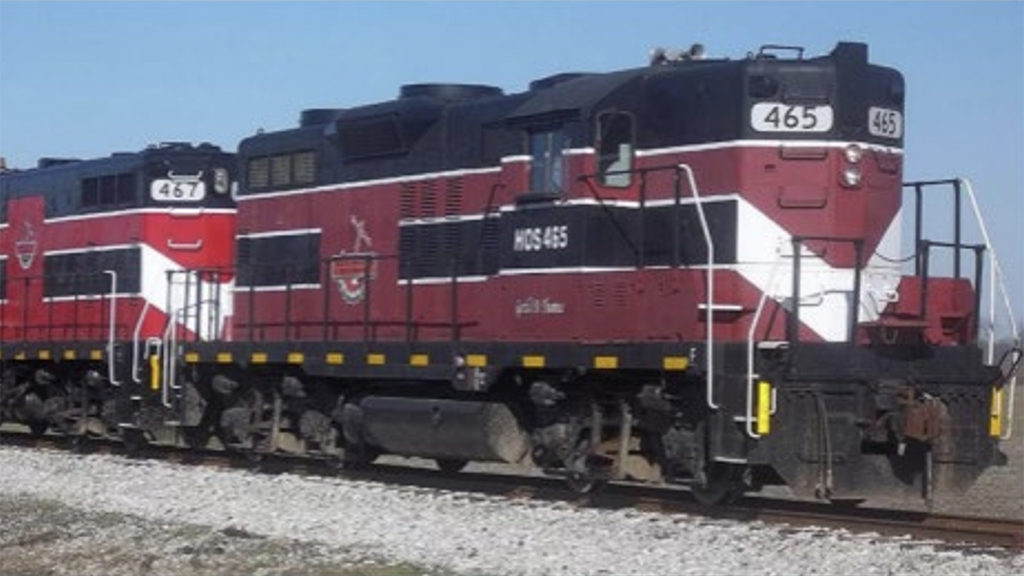
- Louisiana — NEW ORLEANS DOWNTOWN TRANSIT CENTER AND CONNECTING CORRIDORS: New Orleans Regional Transit Authority (RTA) will receive $24.8 million to construct a Downtown Transit Center (DTC) for its streetcar and bus network, including multimodal improvements to the corridor that connects to the DTC. “The new facility will provide enhanced connections for transit riders while making data-driven safety improvements at targeted intersections with a history of pedestrian-involved crashes,” USDOT said. Those improvements include high-visibility sidewalks, security cameras, call boxes, lights, protected bike lanes and shorter crossing distances. According to the Department, project design is also “influenced by a BRT [Bus Rapid Transit] feasibility study, bikeway blueprint, transportation action plan and complete streets policy. The project will enhance bus service in underserved communities and focus on connections to jobs, healthcare, schools and grocery stores. Given the proximity of this project to cultural attractions, the project will also enhance tourist access to the city, and provide economic benefits.”
- Maryland — MONDAWMIN TRANSIT HUB PROJECT: Maryland Department of Transportation Maryland Transit Administration will receive $20 million to fund state-of-good-repair investments at the Mondawmin Transit Station: make station enhancements, reconstruct approximately nine intersections with complete streets enhancements, construct a dedicated bicycle trail, improve pedestrian-only right-of-way, make safety enhancements for pedestrian infrastructure ADA upgrades, and make energy storage generation and stormwater management infrastructure improvements (see image below). The project also includes installation of electric vehicle chargers and conversion of hard infrastructure to green bioretention facilities.
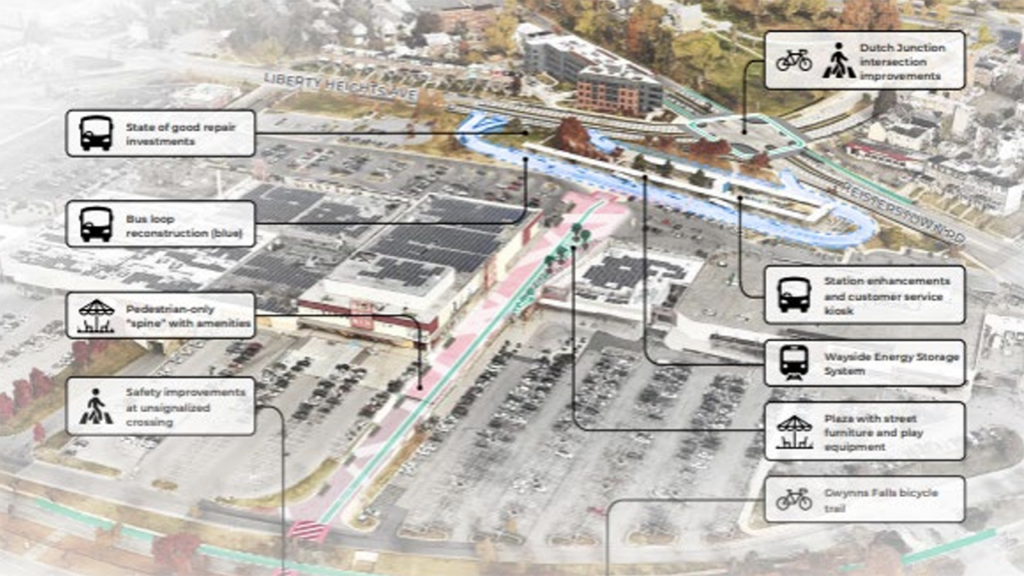
- Pennsylvania — SOUTHWEST PHILADELPHIA TROLLEY MODERNIZATION AND COMPLETE STREETS PROJECT: SEPTA will receive $25 million to implement trolley modernization and complete streets improvements on approximately 3.85 miles of streets. The complete streets portion of the proposed project will be implemented over a 1.5-mile corridor that spans from the intersection of South 49th Street and Woodland Avenue along South 49th Street to the intersection of South 61st Street and Lindbergh Boulevard, as well as South 51st and 56th Streets from Grays Avenue and Lindbergh Boulevard eastward. The trolley modernization portion will be implemented on an approximately 2.75-mile corridor from South 49th Street and Woodland Avenue along South 49th Street, Grays Avenue, Lindbergh Boulevard and Elmwood Avenue until the intersection of Elmwood and Island Avenues, as well as a portion of South 51st Street east of Grays Avenue. “The project focuses on reducing crashes where roadways and trolleys meet and multiple fatalities have occurred in recent years,” USDOT reported. “Lighting will also be installed as a deterrence from criminal activity in hopes to further enhance safety. State of good repair will be addressed by completely renovating aging streets to addressing system vulnerabilities. Significant partnership and collaboration efforts are demonstrated in this project, as it is a collaboration between SEPTA, the city of Philadelphia, and the Philadelphia Industrial Development Corporation. The project is also partnering with the Lower Schuylkill Biotechnology Campus to enhance connections for travelers and allow access to medical and economic institutions. Engagement within the community is evident as planning was based on a study, which synthesized input from the community to prioritize designs.”
- Texas — DOUBLE TRACKING FOR COMMUTER RAIL OPTIMIZATION: Capital Metropolitan Transportation Authority in Austin will receive $18 million to fund the design, engineering and construction of double tracks along the existing Red Line from Onion Street in the west to E. Timbes in the east. The project also includes a second station platform at Plaza Saltillo, signalization, positive train control (PTC) modifications, safer railroad crossings at five locations, construction of new active transportation infrastructure between Chicon and Pedernales, and the reconfiguration of 5th Street, according to USDOT. The project is slated to promote long-term economic growth and other economic investments by improving travel time reliability along the Red Line to downtown and University of Texas – Austin, as well as many small businesses within half a mile of the new stations, the Department said.
- Utah — FIRST/LAST MILE CONNECTIONS: IMPROVING COMMUNITIES’ QUALITY OF LIFE: The Utah Department of Transportation will receive $24.5 million to construct active transportation infrastructure at approximately 10 Utah Transit Authority light rail stops and approximately 13 bus stops in the Wasatch Front metropolitan area. The project addresses mobility and community connectivity by constructing wider sidewalks, wider shoulders, and bicycle accommodations that improve first- and last-mile connections to transit, according to USDOT.
- Washington — BELL ROAD-BNSF RAILWAY GRADE SEPARATION: The city of Blaine will receive $9.5 million to complete 30% design, NEPA compliance and right-of-way acquisition for replacement of the at-grade crossing of BNSF’s Bellingham Subdivision main line with Bell Road (State Route 548). “The replacement will be a grade-separated facility that integrates I-5 ramp realignment, including replacement of the SR 548 Dakota Creek Bridge, construction of a dedicated multiuse path parallel to Bell Road, as well as related transit, flooding, and aquatic habitat improvements within the project boundaries,” USDOT said. “The project will utilize innovative approaches, including low-carbon materials and enhanced stormwater treatment techniques, and design-build project delivery.”



